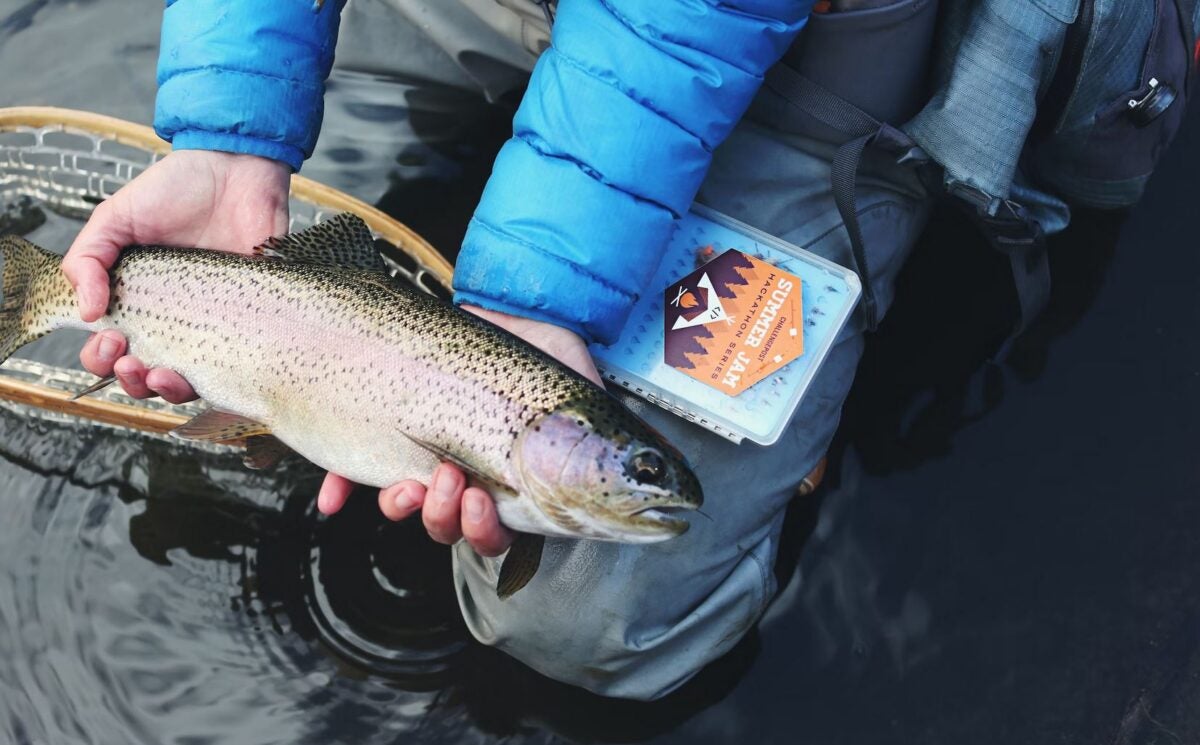Steelhead Fly Fishing – How to Select Gear, Flies, and Insider Tricks
Travis Olander 06.23.23

When summer’s long days begin to wane and the bass stop biting, you needn’t put up the nets and fly rods. You just need to switch your anglin’ game up, and start targeting the right Rainbow Trout. We’re talking about the Steelhead. These feisty fighters start a cold-water migration back into rivers and streams in early November, where they like to hang out through the thick of winter up until mid-April. Steelhead are a hearty fish that thrives in frigid water. That means you can keep the waders on and spool the arbor – but you need to approach steelhead fly fishing with the right gear, flies, and strategy. Let’s dive in.
The Best Fly Rod Setup for Steelhead Fly Fishing
For Steelhead, Get a Switch or Spey Rod
Why? Single-hand rods are great for dry flies, but you’ll find greater success catching Steelhead using subsurface lures and wet flies. That also means mending through currents and generally casting larger, heavier flies. Spey and Switch rods excel at nymphing and setting bottom-dwelling lures with heavy line. A 7-weight single rod, for example, can cast a 160 to 200-grain line. A 7-weight Spey can cast a sinking line that weighs twice to thrice as much. For heavy lures, ripping through spawning beds, and battling those cold winds and fast waters, the Spey will be the best Steelhead hunter.
You may already know that a Spey rod can top out at 14 feet and the appropriate fly line can feel like braided steel. A quality Spey ain’t cheap, either. You might think it’s all overkill, but remember: Steelhead are not your typical rainbows. They easily reach double digits on the hanging scale, they jump like they’re shooting hoops, and they fight like hell. If you’re going to stick with smaller flies and hunt in tight waters, a Switch between 10’8″ and 12′ is the right choice.
The Right Fly Line for Steelhead Fly Fishing
Scandi or Skagit? Either shooting head will work well with a Switch or Spey. You can use typical weight-forward lines, and they’ll work well if you want to try floating and sinking lures, or stick with smaller egg patterns (more on that next). But Scandi or Skagit heads are great for trawling below the surface with larger lures.
Skagit heads are typically easier to cast for beginners. They sport a pretty traditional taper and work well with sinking tips. The smaller head length (20 to 25 feet) makes loading the line a quick and simple task, too. Scandi heads favor tapered leaders and run between 28 and 40 feet. They require a bit more casting prowess, but they’re great for getting real distance and fighting heavy winds and currents.
For Steelhead, Use a 0x to 3x Leader/Tippet
Steelhead have a sharp bite, and the muscle to back it up. You’ll be using heavy flies, so it makes sense to stick with a strong leader and tippet that won’t just snap with the first set hook. Stick with flourocarbon; Steelhead tend to be shy of line.
The Best Flies for Steelhead Fly Fishing
It’s all about the eggs. Steelhead love eggs, especially during spawn season. Salmon eggs, other trout eggs, sucker eggs. You name it. Invest in some proven patterns with orange, pink, and yellow — matching natural color combos is critical.
Nymphs. Sometimes, all you need is the typical twitchy critter to bag a Steelhead. Stick with Sizes 6 to 10, and rely on Hares Ear and Pheasant Tail for quick bites.
Streamers. Most Steelhead streamers are already made for Switch and Spey rods, so it’s a no-brainer to bring along a Pine Squirrel, Clouser, perhaps some Woollys, and Leeches.
Steelhead Fly Fishing: Swing and Drift
When it comes time to get in the water, remember that Steelhead are picky with currents. They prefer a 2- to 3-mph current, and shy away from both brisk flow and standing streams. They also like to sit near tail-outs. That’s where the water bed begins to rise. Steelhead prefer this because it allows them conserve energy and rest.
Finding tail-outs can be difficult, so it’s good practice to swing across the river or stream you’re fishing at a 45-degree angle. Cast far, near the opposite bank, upstream to the target zone. Stick with one or two small mends to keep the right presentation, but let the speed of the drift determine your fly’s pace.
Drag across the width of the channel to cover more ground, and make sure you touch bottom. If you slap an indicator at 4 feet but you’re fishing 10 feet of depth, you’re going to have zero chance of success.
Steelies also don’t like to travel far to take bites. So, if you don’t have luck with the first pass, play with depth and targeting, and don’t be afraid to scrape the same zone a few times.
To dead drift for Steelies, you need to get off the shore. Naturally presentation is always important, so you’re going to want to keep the fly’s direction of travel downstream parallel with your fly line.
Try for Pools and Banks, Too
Steelhead prefer calm, clear waters when they spawn. You might be able to cast in slow pool and banks by sight alone — and that’s a good thing, because they will spook easily. In smaller spots, stick with dead drifting. It may even make sense to get the waders wet and target shallower banks from the middle of a deeper stream or river.




